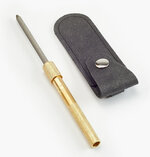I think…
I feel…
Quoting from the Wiki I wrote to introduce my city friends to Western hunting:
Cartridge selection is deceptively simple. First, choose a specific projectile in whose terminal performance you’re confident. Gain that confidence by perusing hunters’ forums with many pictures of dead animals such as
Rokslide. Take the manufacturer’s minimum impact velocity number in fps and find evidence from prior engagements that this impact velocity indeed consistently yields results. Add a buffer of your choosing, such as 100 fps, and correlate this new “AMIV” (adjusted minimum impact velocity) using a ballistic calculator (like Hornady’s 4DOF app) with barrel lengths and cartridges which interest you.
For example, if you have chosen the 6.5mm 143 grain ELD-M projectile, you might explore with 4DOF what performance looks like in a 6.5 Creedmoor, 6.5 PRC, or 6.5 SAUM at various barrel lengths. At whatever distance 4DOF tells you the projectile drops below your AMIV, that’s your max distance for that cartridge.
Is the distance insufficient for your hunting style? Increase the barrel length or cartridge powder load (like going from 6.5 creedmoor to PRC). Is the AMIV distance far beyond your hunting ranges? You’re probably taking too much barrel into the field, or handling too much unnecessary recoil. Cut the barrel down or downsize the cartridge or both.
The impact velocity and the terminal performance of the bullet are the only factors which contribute to killing. Oft-touted figures like energy (measured in ft-lbs) or Killing Power Score (KPS) are old wive’s tales with no objective evidence to back up their use as a guide.
-J


